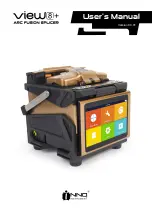
B) Repair measures
- After having carried out a repair, be careful to
re-order the wiring, so that there is a secure insula-
tion between the primary side and the secondary
side of the machine.
- Do not allow the wires to come into contact with
moving parts (i.e. with the fan motor) or parts that
become hot during operation.
- Also re-assemble all the clamps that hold the
wiring, as originally arranged on the machine, so
that, if a conductor is accidentally broken or dis-
connected, it is still possible to avoid a connection
between the primary and the secondary.
- Avoid cleaning the electronic boards with a jet
of compressed air to preserve the integrity of the
components.
- At the end of any repair, make sure that you have
not forgotten any tools inside the machine and
close the machine with all the bulkheads available
and taking care to replace all the fixing devices of
the bulkheads themselves.
7.6. DIAGNOSTICS AND TROUBLE-
SHOOTING
7.6.1. Troubleshooting
•
Before arc welding machines are dispatched from
the factory, they have already been debugged ac-
curately. So forbid anyone who is not authorized
by our company to do any change to the equip-
ment!
•
Maintenance course must be operated carefully. If
any wire becomes flexible or is misplaced, it may-
be potential danger to user!
•
Only professional maintenance personal who is
authorized by our company could overhaul the
machine!
•
Guarantee to shut off the arc welding machine’s
power before turn on the outline of the equip-
ment!
•
If there is any problem and has no the authorized
professional maintenance personal of our compa-
ny, please contact our local agent or the branch
company!
Remove dust or foreign materials every 6 months,
which may have been deposited on the transformer
or on the diodes of the rectifier unit; to do this use a
jet of dry, clean air.
Do not direct the compressed air jet directly onto
the electrical and electronic components so as not to
damage them.
When reassembling the wire feeder roller, after hav-
ing cleaned or replaced it, make sure that the groove
is aligned with the wire and that it corresponds to the
diameter of the wire used.
Keep the inside of the gas nozzle constantly clean,
so as to avoid metal bridges consisting of welding
sprays between the gas nozzle and the contact tip.
Make sure that the output hole of the current collec-
tor nozzle is not excessively enlarged, otherwise re-
place it.
Absolutely avoid beating the torch or subjecting it to
violent impacts.
7.5. WELDING MACHINE REPAIRS
Experience has shown that many accidents originate
from repairs not performed to perfection.
For this reason, careful and complete control over a
repaired welding machine is just as important as that
performed on a new welding machine. Moreover, in
this way, manufacturers can be protected from being
held liable for defects, when the liability is to be at-
tributed to others.
Welding machine repairs must be carried out exclu-
sively by trained and qualified personnel, in posses-
sion of the necessary requisites to guarantee a work-
manlike repair and in full compliance with safety
standards EN 60974-4.
A) Instructions to be followed for repairs
- After rewinding the transformer or the inductanc-
es, the welding machine must pass the same ap-
plied voltage tests, passed at the time of the first
test according to the regulations in force.
- If no rewinding has been carried out, a welding
machine, which has been cleaned and/or over-
hauled, must pass a particular applied voltage test
with values given by current regulations.
- After rewinding and/or replacing parts, the no-
load voltage must not exceed certain values given
by current regulations.
- If repairs are not carried out by the manufacturer,
repaired welding machines, in which some com-
ponents have been replaced or modified, must be
marked so that the person who carried out the re-
pair can be identified.
1.995.234 EN - Rev. 1.1
NOVAMIG 320 LCD
28









































